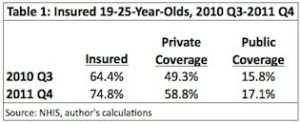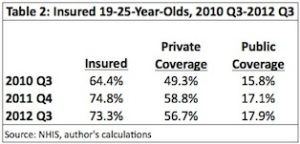01 Apr 2014 A Slacking Figure: Despite What President Obama and the Los Angeles Times Say, 3.1 Million Young Adults Have Not Received Coverage via Their Parents’ Insurance
Yesterday President Obama claimed that “more than 3 million young adults… have gained insurance under this law by staying on their family’s plan.”1
Indeed, the number of young people who can now stay on their parents’ insurance plans until age 26—the so-called “slacker mandate”—is one of the most oft-repeated ObamaCare statistics. The Los Angeles Times used it in a recent article to claim that because of ObamaCare “at least 9.5 million previously uninsured people have gained coverage.”2 That included not only the 3.1 million young adults who are covered by their parents’ plans but also about 2 million on the exchanges and 4.5 million on Medicaid.
The exchange and Medicaid numbers are highly problematic and have been challenged elsewhere.3 Yet the 3.1 million young adults figure seems nearly infallible. For example, when disputing the Medicaid numbers back in January, Ezra Klein claimed, “The 3.1 million young adults who got coverage through the new insurance regulations is a pretty reliable figure.”4
Well, no, it’s not.
The 3.1 million figure comes from a June 2012 report from the Department of Health and Human Services.5 The slacker mandate went into effect in late September 2010. Using data from the Center for Disease Control’s National Health Interview Survey, HHS estimated that the number of 19-25-year-olds with insurance was about 64.4 percent in the third quarter of 2010 and was 74.8 percent in the last quarter of 2011. HHS took that increase of 10.4 percent and multiplied it with the number of 19-25-year-olds in the U.S. in 2011—about 29.7 million according to the Census Bureau—which yielded 3.1 million. (Note: The 29.7 million figure actually refers to the number of 18-24-year-olds in the U.S. in 2010.6 HHS apparently assumed there was that same number of 19-25-year-olds in the U.S. one year later, in 2011.)
The actual data in the National Health Interview Survey7 shows serious shortcomings of the HHS approach:
– See more at: https://nationalcenter.org/NPA658.html#sthash.F6zr0zSS.dpuf

The increase in the number of insured 19-25-year-olds came from both private insurance and public sources such as Medicaid. To get a more accurate assessment of young adults on their parents’ policies, the HHS should have restricted its calculation to the increase in private coverage, which was 9.5 percent. Multiplied against 29.7 million yields 2.8 million, not 3.1 million.
Still, 2.8 million is nothing to sneeze at. However, what’s curious is that HHS hasn’t updated its analysis since June 2012. The June 2012 analysis was an update from a December 2011 report8 that found 2.5 million 19-25-year-olds had gained coverage, which was itself an update on the 1 million figure from a September 2011 report.9
A look at the most recent data10 on 19-25-year-olds from the National Health Interview Survey shows why HHS hasn’t released an update in over 21 months:
– See more at: https://nationalcenter.org/NPA658.html#sthash.F6zr0zSS.dpuf

The number of insured 19-25-year-olds had declined by the third quarter of 2012. Private coverage had dropped by 2.1 percent. Multiply that against the roughly 30 million 19-25-year-olds in the U.S. in 2012, and the number of young people on their parents’ policies declined by about 600,000, to 2.2 million. Apparently the slacker mandate is losing its effectiveness.
There are other reasons to be suspicious of the 3.1 million figure. For starters, it doesn’t jibe with Census Bureau numbers.11 The Census Bureau shows that from 2009, the year before the slacker mandate began, to 2012, the number of uninsured 18-24-year-olds declined by about 976,000. But not all of those went onto their parents’ insurance. For that age group, Medicaid enrollment grew 271,000 and employer-based coverage increased 447,000 during that same period. That would mean that those newly insured by joining their parents’ coverage were at most 258,000.
The huge difference between the two surveys isn’t easy to explain. Undoubtedly part of the explanation is found in the fact that the Census Bureau asks about insurance status only in its surveys from February to April while the National Health Interview Survey asks about it year round. Also contributing to the discrepancy is that neither survey specifically asks a young adult if he or she received coverage via his or her parents’ insurance.
That said, the biggest source of confusion is found in HHS’s methods. What HHS did amounts to little more than a “back of the envelope” calculation. To really get at how many young adults are newly covered under their parents’ policies would require surveys asking very detailed questions about the source of insurance. It would probably also require more sophisticated statistical analysis that could estimate the impact of the slacker mandate while controlling for other factors such as the economy and Medicaid enrollment. As it stands, all we have is an estimate of the number of young adults who gained coverage via their parents that is unreliable—far too unreliable for major newspapers to be repeating it.
David Hogberg, Ph. D., is senior fellow for health care policy at the National Center for Public Policy Research.
Footnotes:
1 “Obama Transcript: Health Law Is ‘Here to Stay,'” Wall Street Journal, April 1, 2014, at http://blogs.wsj.com/washwire/2014/04/01/obama-transcript-health-law-is-here-to-stay/ (April 1, 2014).
2 Noam N. Levey, “Obamacare has led to health coverage for millions more people,” The Los Angeles Times, March 30, 2014, at http://www.latimes.com/nation/la-na-obamacare-uninsured-national-20140331,0,6550360,full.story#axzz2xXzWcpAY(March 31, 2014).
3 Sandhya Somashekar and Lena H. Sun, “Fewer than 2 million signed up for Medicaid under the health law, report says,” The Washington Post, February 5, 2014, at http://www.washingtonpost.com/national/health-science/fewer-than-2-million-signed-up-for-medicaid-under-the-health-law-report-says/2014/02/05/4ac63f3c-8e78-11e3-b227-12a45d109e03_story.html (March 30, 2014); Glenn Kessler, “Durbin’s claim that 10 million now have health insurance because of Obamacare” The Washington Post, February 10, 2014, at http://www.washingtonpost.com/blogs/fact-checker/wp/2014/02/10/durbins-claim-that-10-million-now-have-health-insurance-because-of-obamacare/ (March 30, 2014); Sean Trende, “4 Million Medicaid Enrollees Under Obamacare? Doubtful,” Real Clear Politics, January 7, 2014, at http://www.realclearpolitics.com/articles/2014/01/07/4_million_medicaid_enrollees_under_obamacare_121146.html (March 30, 20140); and David Hogberg, “Why Should The Administration Put Out Propaganda About ObamaCare When The L.A. Times Will Do It For Them?” Amy Ridenour’s National Center Blog, National Center for Public Policy Research, March 31, 2014, at http://www.conservativeblog.org/amyridenour/2014/3/31/why-should-the-administration-put-out-propaganda-about-obama.html (March 31, 2014).
4 Ezra Klein, “Has Obamacare really signed up 10 million people?” The Washington Post, January 6, 2014, at http://www.washingtonpost.com/blogs/wonkblog/wp/2014/01/06/has-obamacare-really-signed-up-10-million-people/ (March 30, 2014).
5 Benjamin D. Sommers, “Number of Young Adults Gaining Insurance Due To The Affordable Care Act Now Tops 3 Million,” ASPE Issue Brief, Office of the Assistant Secretary for Planning and Evaluation, U.S. Department of Health and Human Services, June 19, 2012, at http://aspe.hhs.gov/aspe/gaininginsurance/rb.pdf (March 28, 2014).
6 Carmen DeNavas-Walt, Bernadette D. Proctor and Jessica C. Smith, “Income, Poverty, and Health Insurance Coverage in the United States: 2010,” P60-239, Current Population Reports, U.S. Census Bureau, September 2011, Table C-3, p. 83.
7 Robin A. Cohen and Michael E. Martinez, “Health Insurance Coverage: Early Release of Estimates From the National Health Interview Survey, 2011,” National Center for Health Statistics, Centers for Disease Control, June 2012, Table 8, p. 23.
8 Benjamin D. Sommers and Karyn Schwartz, “2.5 Million Young Adults Gain Health Insurance Due To The Affordable Care Act,” ASPE Issue Brief, Office of the Assistant Secretary for Planning and Evaluation, U.S. Department of Health and Human Services, December 14, 2011, at http://aspe.hhs.gov/health/reports/2011/youngadultsaca/ib.pdf (March 28, 2012).
9 “One Million Young Adults Gain Health Insurance In 2011 Because Of The Affordable Care Act,” ASPE Issue Brief, Office of the Assistant Secretary for Planning and Evaluation, U.S. Department of Health and Human Services, September 21, 2011, at http://aspe.hhs.gov/health/reports/2011/dependentcoverage/ib.pdf (March 28, 2012).
10 Robin A. Cohen and Michael E. Martinez, “Health Insurance Coverage: Early Release of Estimates From the National Health Interview Survey, January-September 2012,” National Center for Health Statistics, Centers for Disease Control, March 2013, Table 8, p. 25.
11 Carmen DeNavas-Walt, Bernadette D. Proctor and Jessica C. Smith, “Income, Poverty, and Health Insurance Coverage in the United States: 2012,” P60-245, Current Population Reports, U.S. Census Bureau, September 2013, Table C-3, p. 73.



